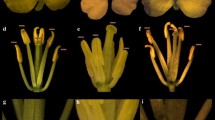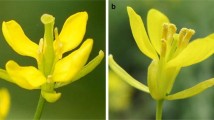Abstract
We report a novel cytoplasmic male sterility (CMS) system in Brassica juncea (oilseed mustard) which could be used for production of hybrid seed in the crop. A male sterile plant identified in a microspore derived doubled haploid population of re-synthesized B. napus line ISN 706 was found to be a CMS as the trait was inherited from the female parent. This CMS, designated ‘126-1’, was subsequently transferred to ten different B. juncea varieties and lines through inter-specific crosses followed by recurrent backcrossing. The F1s of inter-specific crosses were invariably partially fertile, but irrespective of the variety/line used, the recipient lines became progressively male sterile over five to seven generations and could be maintained by crossing the male sterile lines with their normal counterparts. The male sterile lines were found to be stable for the trait under both long and short day conditions. CMS lines when crossed with lines other than the respective maintainer line were restored for fertility, implying that any variety could act as a restorer for ‘126-1’ cytoplasm in B. juncea. These unique features in maintenance and restoration of CMS lines coupled with near normal floral morphology of the CMS lines have allowed the use of ‘126-1’ cytoplasm for hybrid seed production. The uniqueness of ‘126-1’ has been further established by Southern hybridization with mitochondrial DNA probes and by a histological study of the development of male sterile anthers.


Similar content being viewed by others
References
Alexander MP (1969) Differential staining of aborted pollen and non-aborted pollen. Stain Technol 44:117–122
Arumugam N, Mukhopadhyay A, Gupta V, Pental D, Pradhan AK (1996) Synthesis of hexaploid (AABBCC) somatic hybrids: a bridging material for transfer of ‘tour’ cytoplasmic male sterility to different Brassica species. Theor Appl Genet 92:762–768
Arumugam N, Mukhopadhyay A, Gupta V, Pental D, Pradhan AK (2000) Somatic cell hybridization of ‘oxy’ CMS Brassica juncea (AABB) with B. oleracea (CC) for correction of chlorosis and transfer of novel organelle combinations to allotetraploid brassica. Theor Appl Genet 100:1043–1049
Arumuganathan K, Earle ED (1991) Estimation of nuclear DNA content of plants by flow cytometry. Plant Mol Biol Rep 9:229–241
Bannerrot H, Boulidard L, Couderon Y, Temple J (1974) Transfer of cytoplasmic male sterility from Raphanus sativus to Brassica oleracea. In: Wills AB, North C (eds) Proc Eucarpia Meet Cruciferae. Scottish Hortic Res Inst, Invergavrie, UK, pp 52–54
Budar F, Delourme R, Pelletier G (2004) Male sterility. In EC Pua, Douglas (eds) Biotechnology in agriculture and forestry 54. Springer, Berlin Heidelberg New York, pp 43–64
Delourme R, Renard M (1988) Cytoplasmic male sterility in rapeseed (Brassica napus L.): Female fertility of restored rapeseed with “Ogura” and cybrids cytoplasms. Genome 30:234–238
Delourme R, Eber F, Renard M (1991) Radish cytoplasmic male sterility in rapeseed: breeding restorer lines with a good female fertility. Proc 8th Int Rapeseed Congr 5:1506–1510
Fu TD (1981) Production of and research in rapeseed in the People’s Republic of China. Eucarpia Cruciferae Newsl 6:6–7
Gourret J, Delourme R, Renard M (1992) Expression of ogu cytoplasmic male sterility in cybrids of Brassica napus. Theor Appl Genet 83:549–556
Havey MJ (2004) The use of cytoplasmic male sterility for hybrid seed production. In: Daniell H, Chase C (eds) Molecular biology and biotechnology of plant organelles. Springer, Dordrecht, The Netherlands, pp 617–628
Heslop-Harrison J, Heslop-Harrison Y, Shivanna KR (1984) The evaluation of pollen quality and further appraisal of the fluorochromatic (FCR) test procedure. Theor Appl Genet 67:367–375
Heyn FW (1976) Transfer of restorer genes from Raphanus to cytoplasmic male sterile Brassica napus. Eucarpia Cruciferae newsl 1:15–16
Kirti PB, Mohapatra T, Baldev A, Prakash S, Chopra VL (1995a) A stable cytoplasmic male sterile line of Brassica juncea carrying restructured organelle genomes from the somatic hybrid Trachystoma ballii + Brassica jucea. Plant Breed 114:434–438
Kirti PB, Banga SS, Prakash S, Chopra VL (1995b) Transfer of ogu cytoplasmic male sterility to Brassica juncea and improvement of the male sterile line through somatic cell fusion. Theor Appl Genet 91:517–521
Kirti PB, Baldev A, Gaikwad K, Bhat SR, Dinesh Kumar V, Prakash S, Chopra VL (1997) Introgression of a gene restoring fertility to CMS (Trachystoma) Brassica juncea and the genetics of restoration. Plant Breed 116:259–262
Liu Z, Guan C, Zhao F, Chen S (2005) Inheritance and mapping of a restorer gene for the rapeseed cytoplasmic male sterile line 681A. Plant Breed 124:5–8
Mollers C, Iqbal MCM, Roebbelen G (1994) Efficient production of doubled haploid Brassica napus plants by colchicine treatment of microspores. Euphytica 75:95–104
O’Brien TP, McCully ME (1981) The study of plant structure principles and selected methods. Termarcarphi Pty. Ltd., Melbourne Australia
Ogura H (1968) Studies of new male sterility in Japanese radish with special reference to the utilization of sterility towards the practical raising of hybrid seeds. Memoirs of the faculty of agriculture, Kagoshima University, Japan 6:39–48
Pelletier G, Primard C, Vedel F, Chetrit P, Remy R, Rousselle P, Renard M (1983) Intergeneric cytoplasmic hybridization in Cruciferae by protoplast fusion. Mol Gen Gent 191:244–250
Pradhan AK, Mukhopadhyay A, Pental D (1991) Identification of the putative cytoplasmic donor of a CMS system in Brassica juncea. Plant Breed 106:204–208
Pradhan AK, Sodhi YS, Mukhopadhyay A, Pental D (1993) Heterosis breeding in Indian mustard (Brassica juncea L. Czern & Coss): analysis of component characters contributing to heterosis for yield. Euphytica 69:219–229
Prakash S, Raut RN (1983) Artificial synthesis of Brassica napus and its prospects as an oilseed crop in India. Indian J Genet 43:282–290
Prakash S, Chopra VL (1990) Male sterility caused by cytoplasm of Brassica oxyrrhina in B. campestris and B. juncea. Theor Appl Genet 79:285–287
Prakash S, Kirti PB, Bhat SR, Gaikwad K, Dinesh Kumar V, Chopra VL (1998) A Moricandia arvensis-based cytoplasmic male sterility and fertility restoration system in Brassica juncea. Theor Appl Genet 97:488–492
Prakash S, Ahuja I, Upreti HC, Dinesh Kumar V, Bhat SR, Kirti PB, Chopra VL, (2001) Expression of male sterility in alloplasmic Brassica juncea with Erucastrum canariense cytoplasm and the development of a fertility restoration system. Plant Breed 120:479–482
Rao GV, Batra-Sarup V, Prakash S, Shivanna KR (1994) Development of a new cytoplasmic male-sterile system in Brassica juncea through wide hybridization. Plant Breed 112:171–174
Rogers SO, Bendich AJ (1994) Extraction of total cellular DNA from plants, algae and fungi. In: Gelvin S.V., Shilperoot R.A. (eds) Plant molecular biology mannual. Kluwer, Dordrecht, The Netherlands, pp 1–8
Sirivastava A, Gupta V, Pental D, Pradhan AK (2000) AFLP-based genetic diversity assessment amongst agronomically important natural and some newly synthesized lines of Brassica juncea. Theor Appl Genet 102:193–199
Acknowledgments
This work was supported financially by the Dhara Vegetable Oil & Food Company Ltd. (DOFCO), a subsidiary of the National Dairy Development Board (NDDB), India. We thank B. S. Yadav and Sanjay Saxena for technical help.
Author information
Authors and Affiliations
Corresponding author
Additional information
Communicated by H. C. Becker.
Rights and permissions
About this article
Cite this article
Sodhi, Y.S., Chandra, A., Verma, J.K. et al. A new cytoplasmic male sterility system for hybrid seed production in Indian oilseed mustard Brassica juncea . Theor Appl Genet 114, 93–99 (2006). https://doi.org/10.1007/s00122-006-0413-0
Received:
Accepted:
Published:
Issue Date:
DOI: https://doi.org/10.1007/s00122-006-0413-0




